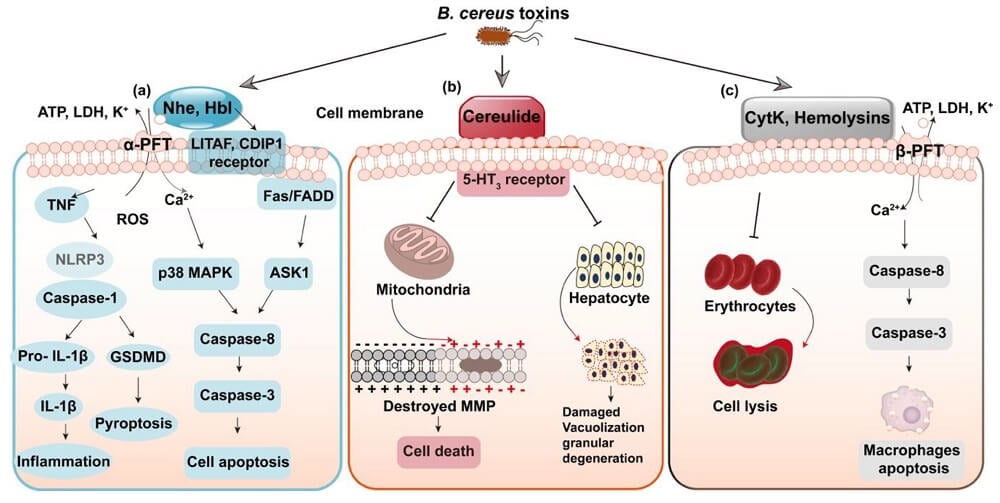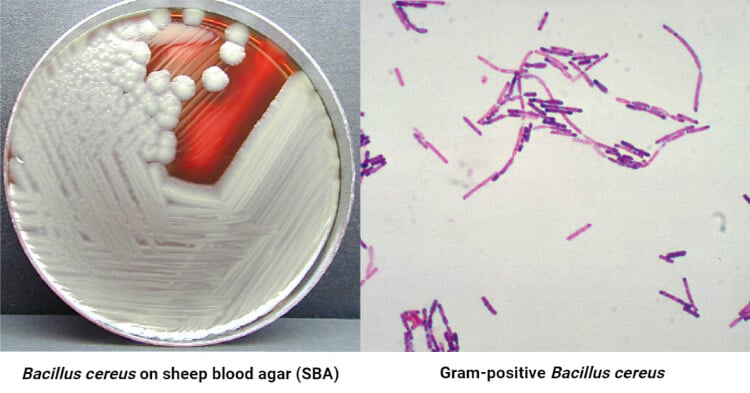Interesting Science Videos
What is Bacillus cereus?
Bacillus cereus is a pathogenic food-borne illness-causing organism that is widely distributed in nature such as on plants, soils, and GI tracts of insects and mammals.
- They are also present in food production plants and are capable of contaminating a large number of raw materials and food products due to their resistant endospores that can survive in harsh conditions.
- Bacillus cereus is a causative pathogenic organism that causes two types of food poisoning disease: the diarrheal type and the emetic type.
- Bacillus cereus produces a complex enterotoxin in the small intestine which causes a diarrheal type of food poisoning and the consumption of food with the presence of heat-stable toxins causes an emetic type of food poisoning.
- It causes opportunistic infections such as bacteremia, septicemia, pneumonia, meningitis, gastritis, liver failure, liver necrosis and brain edema.
- Other species belonging to Bacillus that are responsible for causing food-borne illness are B. subtilis, B. licheniformis, B. pumilus, B. weihenstephanensis, B. anthracis, B. mycoid, B. pseudomycoides and B. thuringiensis.
Biological characteristics of Bacillus cereus
- Gram-positive bacteria
- Spore-former
- Aerobic-to-facultative
- Motile
- Rod-shaped bacilli
- Grow on temperature range (8 – 55°C)
- Optimum temperature – 25 to 37°C
- pH range (4.9 – 9.3)
- Salt concentration up to 7.5%
- Endospores are resistant to high heat, radiation, desiccation and disinfectants.
Sources of contamination
- Due to the heat-resistant spore of B. cereus, it is capable of contaminating the whole food processing units from the raw materials to packaging and storage.
- The biotechnological equipment and machines are also contaminated.
- The organism is inhabitat to soil and is transmitted to the vegetables and crops easily.
- Food products such as rice, wheat, pasta, flour, dairy products, meat products, spices, infant foods, fish, soups, vegetables and fruits are frequently contaminated.
- B. thuringiensis used as a biopesticide produces enterotoxins when spread on plants and vegetation affects the health of a consumer.
- Many outbreaks have been reported in the case of food consumed by B. cereus contamination.
Epidemiology and outbreaks of Bacillus cereus Food Poisoning
- The outbreak caused by the Bacillus cereus was first reported in Norwegian hospitals but no specific populations have been described.
- The outbreak was only characterized by watery diarrhea affecting elderly people and those who have low stomach acid.
- Later in 1971 in the United Kingdom, people consumed contaminated rice from a Chinese restaurant and suffered from nausea and vomiting which involved 1000 cases.
- Bacillus cereus food poisoning is the third most common bacterial outbreak in Hungary with 117 outbreaks between 1960 to 1968.
- In Japan, between 1982 to 1986, 73 outbreaks were reported caused by B. cereus with 1,323 cases.
- In Taiwan, 26,173 cases with 20 deaths were reported out of which 18% of the cases were by B. cereus food poisoning.
- The food poisoning of B. cereus is reported every year and from every geographically distributed nation like Scotland, Japan, UK, Iceland, England and Wales, Northern Europe and North America.
- A low number of outbreaks has been reported in England and Wales, Japan, the USA and Canada as compared to other countries which may be due to different cooking and eating habits.
Bacillus cereus foodborne toxins
Bacillus cereus produces protein toxins namely diarrheal toxin and emetic toxin.
Diarrheal toxin
- A diarrheal toxin is formed when vegetative cells containing foods are consumed and it starts to grow in the small intestine.
- Diarrheal toxins are proteases sensitive such as pronase, pepsin, trypsin and chymotrypsin.
- The total infectious dose capable of causing diarrheal illness is about 104 to 109 cfu/gm.
- The incubation period starts from 8 to 16 hours of ingestion and lasts only for 24 to 48 hours.
- Symptoms are mild with watery diarrhea and abdominal cramp.
- In some cases, children and immunocompromised patients suffer from bloody diarrhea and necrotic enteritis which results in liver failure and brain edema.
- There are three chromosomally encoded enterotoxins associated with diarrheal illness: Hemolysin BL (Hbl), Nonhemolytic enterotoxin (Nhe) and Cytotoxin K (CytK).
- Hbl is a primary virulence factor in B. cereus diarrheal food poisoning which forms a transmembrane pore in the small intestine by osmotic lysis.
- Nhe has similar homology to Hbl with a three-part component and a pore-forming toxin.
- CytK is similar to a prototype toxin that causes bloody diarrhea and necrotic enteritis. It is a β-barrel pore-forming toxin.

Emetic toxin
- The emetic response is more severe and acute which is caused by a small cyclic heat-stable peptide.
- The incubation period starts from 2 to 5 hours of ingestion of preformed contaminated foods.
- About 105 to 108 cells per gram are required to show the illness.
- The symptoms are similar to S. aureus food poisoning which includes nausea, vomiting and abdominal cramp which may last for 24 hours.
- The mode of emetic toxin action is still unknown but it is believed that the 1.2kDa cereulide toxin forms ion channels and holes in the membrane.
- An emetic toxin is heat stable and can survive cooking procedures like frying, roasting, boiling and microwaving.
- Other environmental factors such as temperature, pH, atmospheric composition, nutrient sources and food consistency are associated with B. cereus toxicity.
Detection methods of Bacillus cereus
1. Culture methods
- Laboratory media such as nutrient agar or blood agar are used for B. cereus culture.
- But polymyxin B resistant B. cereus requires selective media such as polymyxin B-pyruvate-egg yolk-mannitol-bromothymol blue agar (PEMBA) and mannitol-egg yolk-polymyxin B agar (MYP).
- Pink colonies with a clear zone of precipitation can be observed after 24 hours of incubation.
- The most probable number (MPN) technique is used when there is a minimum number of organisms present in the sample.
- Presumptive, confirmatory and completed tests are carried out to confirm the presence of B. cereus.

2. ELISA
- ELISA technique is used commercially and is used to measure the toxins but it has no accuracy in assessing the toxin-producing activity of B. cereus.
- It detects only one toxin either the hemolysin BL or two nontoxic proteins.
3. Reverse passive latex agglutination (RPLA) enterotoxin assay
- The sample is boiled to inactivate them biologically which yields a positive result.
- This test recognizes the hemolysin B component but in the presence of high glucose concentration, the toxins are undetectable.
4. PCR
- Amplifying the B. cereus DNA sequence, the presence of toxin can be detected using PCR assays.
- The toxin genes prevent the information about the virulence strains and further complementary tests should be done.
Treatment of Bacillus cereus Food Poisoning
- Bacillus cereus food poisoning is self-limiting that resolves within 24 to 48 hours.
- Bed rest with fluid therapy is a must and if the illness is severe it can also be treated with antibiotics such as clindamycin, vancomycin, gentamicin and chloramphenicol.
Prevention and control measures of Bacillus cereus Food Poisoning
- The spores of B. cereus are extremely resistant to heat treatment even proper cooking kills the vegetative cells but the spores remain viable.
- Therefore, the contamination should be eliminated before the germination of spores.
- Rapid cooling of food before storage and proper reheating before consumption must be done.
- Foods with low pH (4.3) are safe to consume as Bacillus spp. are not able to survive in low acidic food products.
- In food processing plants, trace the presence of spores from farm to packaging.
- Proper food handling practices and good hygiene should be maintained.
- Educate food handlers on food safety management and aware farmers of the illness to eliminate food poisoning.
References
- Granum, P. E., & Lund, T. (2006). Bacillus cereus and its food poisoning toxins. FEMS Microbiology Letters, 157(2), 223–228.
- Tewari, A., & Abdullah, S. (2014). Bacillus cereus food poisoning: international and Indian perspective. Journal of Food Science and Technology, 52(5), 2500–2511.
- Parihar, H. S. (2014). Bacillus cereus. Encyclopedia of Toxicology, 353–354.
- Batt, C. A. (2014). BACILLUS | Bacillus cereus. Encyclopedia of Food Microbiology, 124–128.
- Carlin, F. (2016). Bacillus cereus and Other Bacillus sp. Causing Foodborne Poisonings, Detection of. Encyclopedia of Food and Health, 301–306.
- Marrollo, R. (2016). Bacillus cereus Food-Borne Disease. The Diverse Faces of Bacillus Cereus, 61–72.
- Drobniewski, F. A. (1993). Bacillus cereus and related species. Clinical Microbiology Reviews, 6(4), 324–338.

The notes are highly comendable